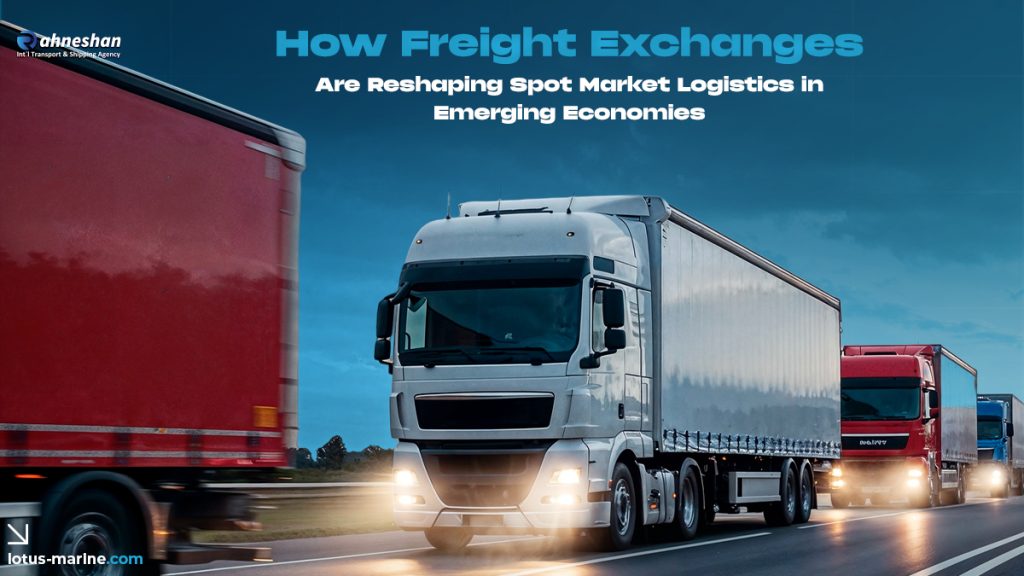Introduction
In many emerging economies, logistics inefficiencies have long been fueled by fragmented networks, lack of transparency, and manual freight matching. The rise of digital freight exchanges—online platforms connecting shippers and carriers in real time—is changing that landscape. By digitizing the spot market for transport, these exchanges are driving efficiency, reducing empty miles, and unlocking new economic opportunities across Asia, Africa, and Latin America.
What Are Digital Freight Exchanges?
A freight exchange is an online marketplace where carriers list available capacity and shippers post loads needing transport. The platform’s algorithms automatically match supply with demand, enabling instant quotes, digital contracts, and GPS-based tracking.
Unlike traditional brokers, digital exchanges use AI, automation, and transparent pricing to make logistics faster, cheaper, and more reliable.
Why They Matter in Emerging Economies
1. Solving Fragmentation
Most transport networks in emerging markets are dominated by small or independent truck operators. Freight exchanges provide a centralized ecosystem, connecting thousands of shippers and carriers who previously operated offline.
2. Boosting Asset Utilization
With data-driven matching, carriers can minimize empty return trips, improving profitability and sustainability.
3. Real-Time Pricing Transparency
Spot rate algorithms—based on market data, fuel costs, and route demand—create fairer pricing and reduce negotiation time.
4. Enabling Financial Inclusion
Digital freight exchanges often integrate e-wallets, payment gateways, and credit scoring, helping small carriers access faster payments and micro-financing options.
5. Improving Supply Chain Visibility
IoT-enabled tracking and digital documentation bring end-to-end visibility to previously opaque freight corridors.
Technology Driving the Change
-
Artificial Intelligence (AI): Predicts demand surges and recommends optimal carrier–shipper matches.
-
Blockchain: Ensures secure and tamper-proof digital contracts.
-
Mobile Platforms: Enable small fleet operators in rural regions to participate with just a smartphone.
-
Data Analytics: Identifies high-demand corridors and optimizes network efficiency.
Key Examples from Emerging Markets
-
India: Platforms like BlackBuck and TruckSuvidha connect over 1 million truckers to real-time loads, reducing empty miles by up to 25%.
-
Brazil: FreteBras facilitates over 700,000 freight transactions monthly, streamlining domestic trade routes.
-
Kenya and Nigeria: Local startups like Lori Systems and Kobo360 digitalize long-haul trucking, offering instant pricing and driver performance tracking.
Challenges to Overcome
-
Digital Divide: Limited connectivity in rural regions still restricts participation.
-
Trust & Data Security: Shippers and carriers must gain confidence in digital contracting and payments.
-
Regulatory Barriers: Inconsistent freight taxation and documentation requirements can slow adoption.
-
Payment Delays: Despite digital tools, cash flow issues persist where traditional banking infrastructure is weak.
Future Outlook
By 2030, freight exchanges could become the default mechanism for spot logistics in many emerging economies. Integration with electronic consignment notes (eCMR), AI route optimization, and digital customs systems will make cross-border operations smoother.
As adoption grows, these platforms won’t just modernize freight—they’ll empower small carriers, enhance trade efficiency, and accelerate economic growth.
Conclusion
Freight exchanges are redefining the spot market logistics model in emerging economies by connecting fragmented players, improving transparency, and enabling smarter freight matching. With continued digitalization and policy support, they’re set to become the backbone of efficient, tech-driven logistics across developing regions.
Frequently Asked Questions
1. What is a freight exchange platform?
It’s an online marketplace that connects shippers and carriers, matching available capacity with freight in real time.
2. How do freight exchanges benefit carriers?
They reduce empty miles, provide faster payments, and improve route utilization.
3. Are freight exchanges replacing brokers?
Not entirely—they’re digitizing the broker’s role with automation and transparency.
4. What are the main challenges in emerging economies?
Connectivity gaps, regulatory complexity, and limited digital literacy.
5. What’s next for digital freight exchanges?
Integration with blockchain, AI, and paperless trade systems to create fully connected, borderless logistics.







